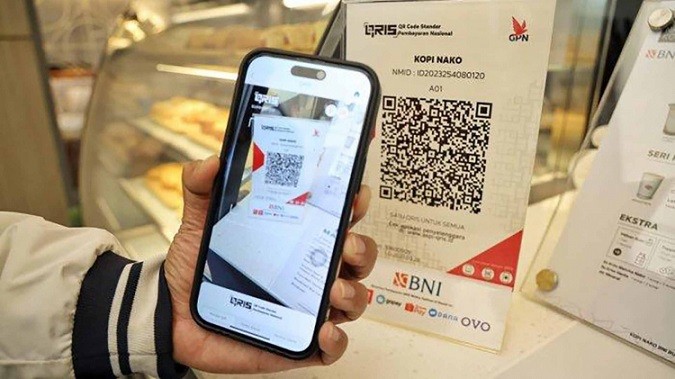
ASEAN and digital transformation efforts
Latest
 |
| The presence of QRIS for cross-border transactions makes Indonesia a leader in ASEAN in digital payment transactions. (Source: Tribunnews) |
Digital transformation is a strategy aimed at building a sustainable ASEAN Community, with political cohesion, economic linkages and shared social responsibilities, ensuring ASEAN’s central position in dynamic Asia.
Cross-border payments
A regional cross-border payment system that Southeast Asian countries have recently implemented is expected to help strengthen financial integration among participating countries, bringing ASEAN closer to the goal of economic cohesion.
Five countries including Indonesia, Malaysia, Singapore, Thailand and the Philippines have agreed to cooperate on ASEAN cross-border payments using QR codes or e-wallets to help make payments fast and users can transact in local currencies.
The major banks of these five countries, including Bank Indonesia (BI), Bank Negara Malaysia (BNM), Monetary Authority of Singapore (MAS), Bank of Thailand (BOT), and Bangko Sentral ng Pilipinas (BSP) work together to create a cross-border payment system in ASEAN that is faster and cheaper, more inclusive and transparent.
According to the agreement, these banks commit to using the local currencies of all ASEAN countries as official payment instruments and are converted at the current exchange rate in each country.
In January 2023, Indonesia and Malaysia tested a cross-border payment system using QR codes and became the official payment method on May 8, 2023.
Previously, cross-border payment cooperation using QR codes was successfully deployed in Thailand and Indonesia.
Data from Bank Indonesia shows that the number of transactions by Indonesian tourists in Thailand using QR codes reached 14,555 times, with a value of 8.54 billion Rp (Indonesian Rupiah, about 13.4 billion VND). Meanwhile, the number of transactions by Thai tourists in Indonesia with QRIS is 492 transactions, worth 114 million Rp (179 million VND).
QRIS combines different QRs from payment system service providers for more centralized and convenient transactions. Users don't need an account or use multiple apps to pay. Thanks to that, digital transactions using QR codes become easier, faster and safer.
Bank Indonesia is promoting the use of QRIS as an official payment method in other ASEAN countries so that each central bank can standardize digital payments using digital financial applications, such as banking mobile and e-wallet.
Easy and fast payments can enhance trade and tourism within ASEAN. For example, Indonesian tourists do not need to have Ringgit currency when transacting in Malaysia. The QRIS payment system will instantly convert Rupiah to Ringgit at the prevailing exchange rate upon making the transaction.
At the ASEAN Summit last May, leaders also reiterated their commitment to the project, pledging to build a roadmap to expand regional payment links to all 10 ASEAN members.
This programme aims to support and facilitate cross-border trade payments, investments, remittances and other economic activities, aiming to deploy a comprehensive financial system throughout the Southeast Asia.
Nico Han, Southeast Asia analyst at Diplomat Risk Intelligence, the consulting and analysis arm of The Diplomat magazine said: “A unified cross-border digital payments system will promote awareness of regionalism and the central role of ASEAN in the management of international affairs”.
| On September 3, negotiations on the ASEAN Digital Economy Framework Agreement (DEFA) were launched within the framework of the 23rd ASEAN Economic Community Council (AECC) Conference, demonstrating strong cooperation. among ASEAN countries in promoting digital economic transformation in the region. This is considered an important step forward in cooperation between ASEAN countries to exploit the great potential of the digital economy. |
Narrow the gap
Promoting digital transformation to recover from the COVID-19 pandemic in ASEAN and enhance the region's competitiveness in the medium and long term is considered one of the five main recovery strategies of the ASEAN Overall Recovery Framework, which are: strengthen the healthcare system; ensure human security; develop markets and internal links; promote digital transformation; Sustainable Development.
In January 2021, ASEAN emphasized the importance of digitalization through the ASEAN Digital Masterplan 2025 (ADM) announced at the first ASEAN Digital Ministerial Conference. The above plan aims to make ASEAN a leading digital community and digital economic bloc with the support of digital transformation services, technology and ecosystem, ensuring cybersecurity to promote trusted digital space.
However, narrowing the gap and ensuring equality in digital access between countries in the region as well as between people within each country is one of the important factors in building a cohesive ASEAN digital community. At an online conference with the theme of “Bridging the digital gap in ASEAN” in September 2021, experts said that as the adoption of digitalization increases, ASEAN governments need to invest more in infrastructure.
According to experts: the people, especially rural areas and small businesses in ASEAN, should be ready to adapt to create economic value after being connected. A comprehensive approach is essential to achieve equitable and effective outcomes.

















